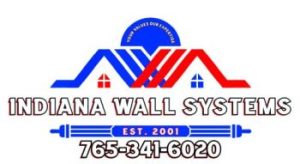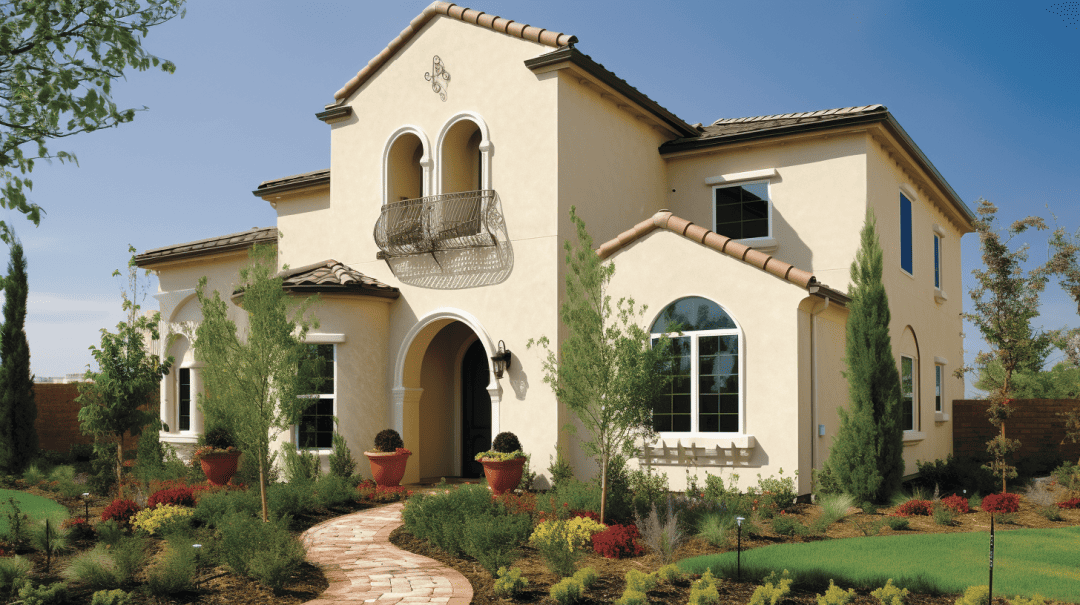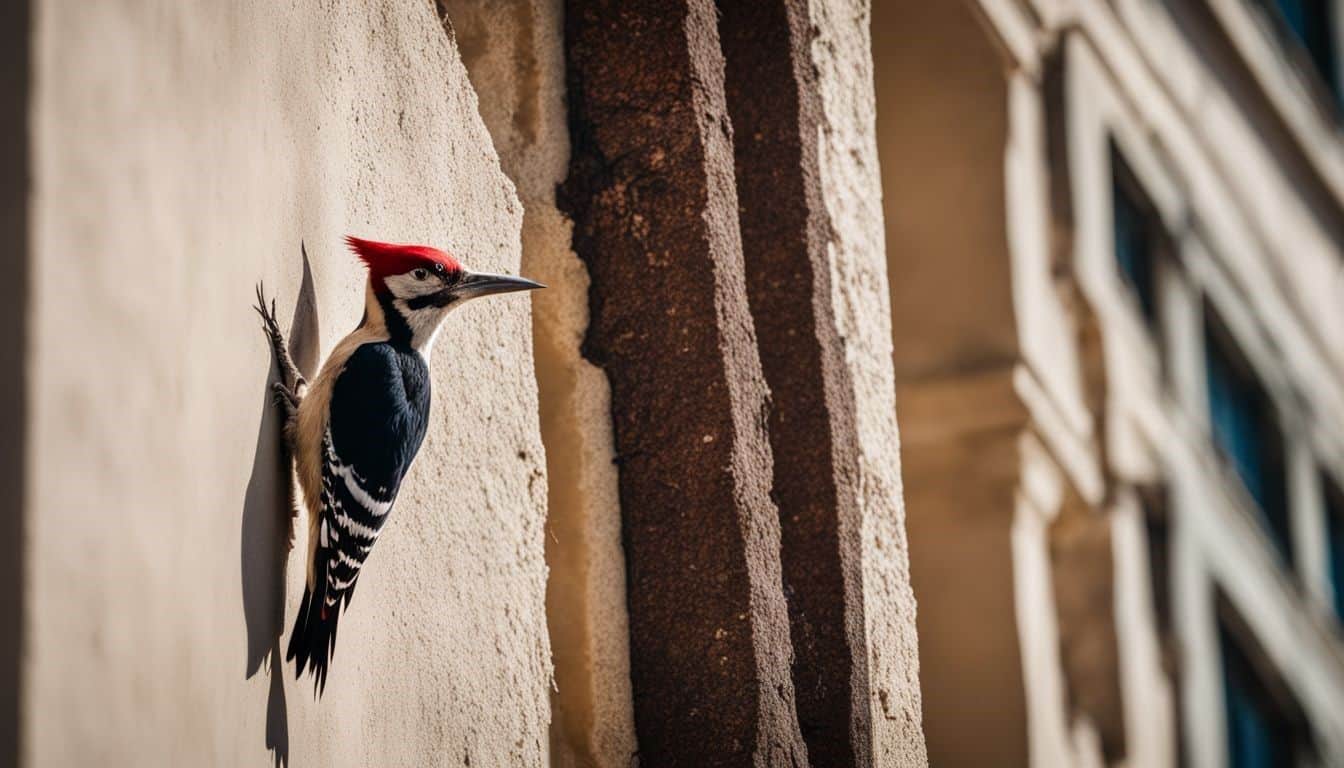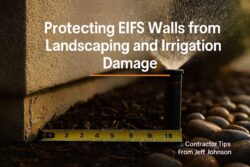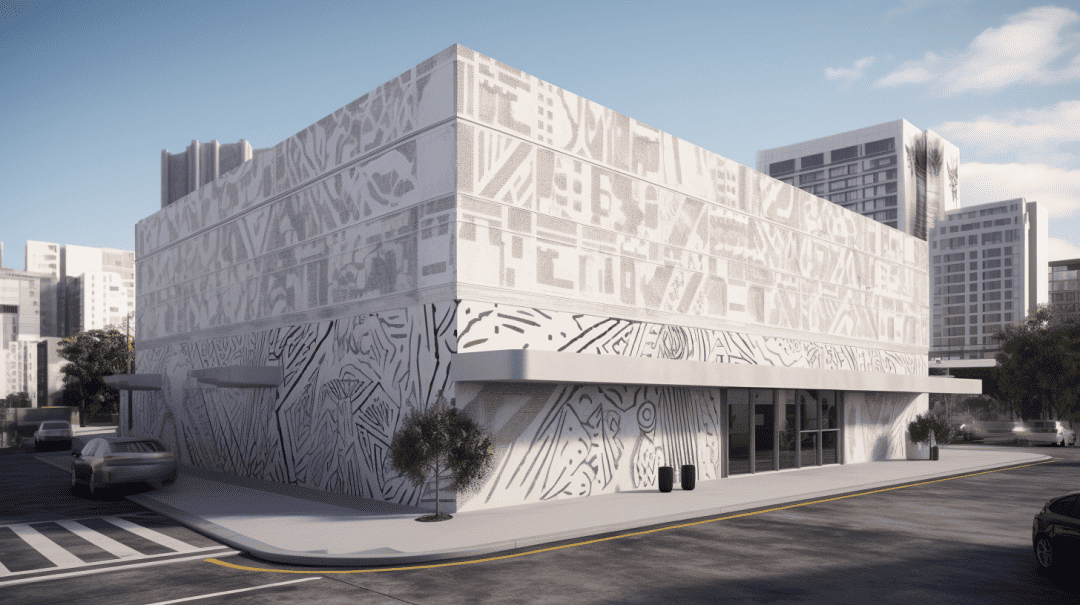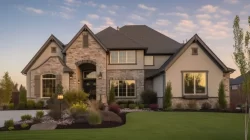Discover Expert Tips to Shield Your EIFS from Harsh UV Rays, Preserve Its Vibrant Finish, and Extend Its Longevity for Decades to Come
Sun damage and fading can ruin the look of your EIFS walls over time. A well-kept EIFS system can last up to 60 years with proper care and protection from UV rays. This guide shows you simple steps to shield your EIFS from harsh sunlight and keep its fresh look longer.
Learn proven ways to stop color fading and protect your home’s value.
Key Takeaways
- EIFS systems can last 30-60 years with proper care, but need protection from UV rays that cause fading and surface damage.
- Regular checks every 6 months help catch problems early. Fix small cracks fast to stop water damage and mold growth.
- UV-resistant and elastomeric coatings create a shield that lets walls breathe while blocking harmful sun rays. These coatings last 5-7 years.
- Clean EIFS walls twice yearly with mild soap and soft brushes. Never use harsh chemicals or power washers.
- Light colors like beige and gray show less fading than dark shades. Keep EIFS walls at least 6-8 inches above ground level to prevent water damage.
Understanding EIFS and Its Vulnerability to Sun Damage
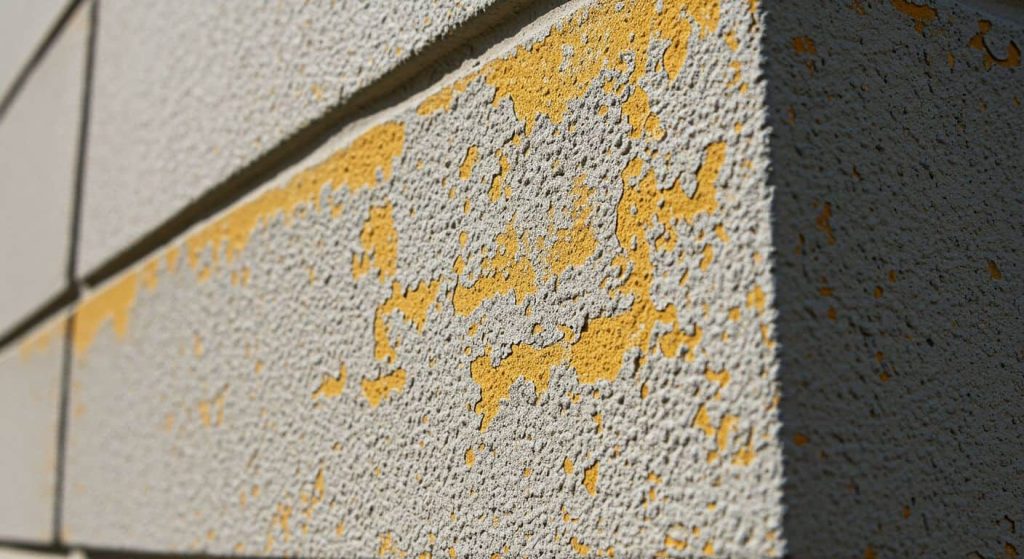
EIFS systems face daily battles against harsh UV rays that can break down their protective layers over time. Direct sunlight exposure leads to color changes and surface damage that can harm your building’s outer shell.
What is EIFS?
Exterior Insulation and Finish Systems (EIFS) stands as a modern wall cladding that combines insulation with a protective finish. This system creates a strong outer shell for buildings that can last 30 to 60 years with proper care.
The finish coat protects against harsh weather while the insulation layer helps cut energy costs.
Property owners choose EIFS for its mix of beauty and function. The system includes layers that work together – insulation board, base coat, mesh, and an acrylic finish that fights UV rays.
Most EIFS setups need to stay at least 6 inches above ground level to stop water damage. Regular checks and quick fixes help this cladding system stay strong and keep its good looks for decades.
How Sunlight Affects EIFS Over Time
Sunlight hits EIFS surfaces daily and causes slow but steady damage over time. UV rays break down the protective coating that shields your EIFS from harm. The sun’s intense heat makes colors fade and creates tiny cracks in the surface.
These problems start small but grow bigger without proper care.
Your EIFS system needs good maintenance to last its full 30-60 year lifespan. UV-resistant coatings guard against sun damage and keep the surface looking fresh. Regular checks help spot early signs of trouble before they turn into costly fixes.
Small repairs now stop bigger headaches later. The right care keeps your EIFS strong through years of harsh weather and hot summers.
Common Signs of Sun Damage and Fading in EIFS
Sun damage on EIFS surfaces shows clear warning signs that property owners must spot early. Fading colors, surface cracks, and peeling spots signal that your EIFS needs quick attention to stop bigger problems from growing.
Discoloration and Fading
EIFS walls can lose their bright colors over time. The sun’s rays break down the coating and make colors fade within 5-10 years. Most property owners notice yellow or brown patches on their walls first.
These spots show up more on darker colored surfaces than lighter ones.
Your EIFS finish needs care to stay fresh and vibrant for its full 30-60 year lifespan. UV-resistant coatings help fight color changes and keep your walls looking new. Regular checks can spot early signs of fading before they spread across large areas.
The right protective coating creates a shield between harsh sunlight and your EIFS surface, keeping its good looks longer.
Cracking and Surface Deterioration
Beyond color changes, sun damage leads to serious surface problems. The strong UV rays break down the protective layers of EIFS over time. Small cracks start to form on the surface, creating paths for water to seep inside the wall system.
Surface damage gets worse if left alone. Cracks grow bigger and deeper, putting the whole wall at risk. The system can last 30 to 60 years with proper care, but sun-damaged areas need quick fixes.
Regular checks help spot these issues early. A qualified EIFS expert should repair any cracks right away to stop moisture from getting trapped inside the walls.
Loss of Protective Coating
Surface cracks often lead to a bigger problem – the loss of your EIFS protective coating. The outer layer shields your walls from harsh weather and UV rays. EIFS can last 30 to 60 years with proper care, but damaged coatings cut this life short.
Your EIFS coating plays a vital role in moisture control and energy efficiency. The coating creates a water-tight seal that stops rain from getting inside your walls. Missing or weak spots in this barrier let water seep in.
This causes mold growth and wood rot over time. A strong coating also helps your building stay cool in summer and warm in winter. Regular checks can spot coating issues early. Most coating problems need quick fixes to stop bigger damage later.
Why Protecting EIFS From UV Damage Is Essential
UV rays break down EIFS coatings and cause fading that ruins your building’s curb appeal. Your EIFS system needs proper protection from sun damage to maintain its insulating properties and prevent costly structural repairs.
Preserving Structural Integrity
EIFS walls need strong support to last 30-60 years. Regular checks help spot small problems before they grow into big issues. Proper care stops moisture damage that leads to mold and wood rot.
Your EIFS system must stay at least 6 inches above ground level to block water damage.
Good maintenance keeps your EIFS strong through harsh weather. The outer layer guards against rain, sun, and wind – but needs care to work right. Small fixes now cost less than major repairs later.
Most property owners save money with yearly EIFS checks that catch problems early.
Maintaining Aesthetic Appeal
A well-kept EIFS surface stays beautiful for 25 to 60 years. Regular cleaning and proper care keep the colors bright and fresh on your property. Your building needs UV-resistant coatings to stop fading and protect its good looks.
Most property owners see their EIFS stay attractive with simple yearly checks and quick fixes.
Property value goes up with a clean, fade-free exterior finish. Smart owners use high-performance coatings that fight off sun damage and keep the walls looking new. The right care stops chalking and keeps the surface smooth.
Your next step is learning why strong walls matter for your building’s health.
Extending Lifespan of EIFS
Beautiful EIFS walls need proper care to stay strong and last longer. Regular upkeep helps your EIFS system reach its full life span of 30 to 60 years. Smart maintenance keeps the walls looking fresh while protecting your investment.
Property owners must check their EIFS walls each year for damage. Quick fixes of small cracks stop bigger problems later. Clean surfaces with mild soap and water to remove dirt. UV-resistant coatings shield the walls from harsh sun rays.
These steps guard against mold, wood rot, and metal rust inside the walls. Good care saves money on costly repairs and keeps energy bills low. Your EIFS cladding works better at keeping heat and cold where they belong – outside in summer, inside in winter.
Preventative Measures to Protect EIFS From Sun Damage
Regular checks and quick fixes help your EIFS stay strong against harsh sun rays – read on to learn the simple steps that shield your walls from UV damage and keep them looking fresh year after year.
Regular Inspections and Maintenance
Property owners must check their EIFS surfaces every six months. A quick visual scan helps spot early signs of damage, fading, or cracks. Most EIFS systems can last 25 to 60 years with proper care and upkeep.
Experts suggest looking for color changes, surface wear, and moisture spots during these checks.
The right maintenance plan keeps EIFS strong and beautiful. Clean the surface with mild soap and soft brushes to remove dirt. Fix small cracks fast before they grow bigger. Your EIFS needs space above ground level to stop water damage.
Smart care now saves money on big repairs later. Proper upkeep helps your EIFS resist UV rays and stay fresh-looking longer.
Cleaning and Removing Dirt or Debris
Regular checks lead straight to proper cleaning tasks. Dirt and debris must be cleaned from EIFS surfaces with mild detergent and soft brushes. Most EIFS systems can last 30 to 60 years if kept clean and well-maintained.
A gentle wash with water helps remove surface grime that could harm the protective coating.
Harsh chemicals or power washers must never touch EIFS surfaces. The right cleaning method keeps your EIFS looking fresh while stopping moisture damage. Simple soap and water mix works best for routine cleaning.
Soft scrub brushes help lift dirt without harming the finish. Clean EIFS walls at least twice each year to prevent build-up that could trap moisture against the surface.
Repairing Small Cracks and Damage Promptly
Small cracks in EIFS need quick fixes to prevent bigger problems. If you fix damage fast, your EIFS can last 30 to 60 years. Moisture damage leads to mold and wood rot, which costs a lot to fix.
Most property owners spot tiny cracks during their yearly checks and call pros right away. The right repairs help your EIFS stay strong against UV rays and harsh weather.
Proper crack repair starts with cleaning the area and using special EIFS-friendly materials. The repair team must match your current finish for a perfect blend. They will seal the crack with flexible coating that moves with your building.
This step keeps water out and helps your EIFS stay dry. Your next step is learning about protective coatings that guard against sun damage.
Applying Protective Coatings to Safeguard EIFS
Protective coatings create a shield between your EIFS surface and harmful UV rays. A high-quality coating stops color fading and extends the life of your exterior walls through proper sealing.
Benefits of UV-Resistant Coatings
UV-resistant coatings create a strong shield for EIFS surfaces against harsh sunlight. These special coatings last up to 25 years and stop color fading on your building’s exterior.
They form a tough barrier that blocks harmful rays while letting the wall breathe properly.
Your EIFS needs the right protection to reach its full 30-60 year life span. A quality UV-resistant coating helps your building stay beautiful and cuts down repair costs. The coating fights off sun damage, keeps colors bright, and stops surface cracks from forming.
Most property owners see better energy savings too, since these coatings help maintain the EIFS insulation power.
Elastomeric Coatings for Enhanced Protection
Elastomeric coatings create a strong shield for EIFS surfaces against harsh sun rays. These special coatings stretch and move with your building’s surface, stopping cracks from forming.
Property owners can expect their EIFS to last 30 to 60 years with proper coating protection. The coating acts like a thick rubber blanket that keeps moisture out while letting the wall breathe.
Professional coating systems offer up to 300% more stretch than regular paint. This means your EIFS stays protected even during big temperature changes. The coating forms a seamless layer that blocks water and harmful UV rays from damaging your walls.
Most elastomeric coatings need just one coat every 5-7 years to keep your building safe and looking fresh.
Breathable Coatings for Moisture Control
Breathable coatings play a vital role in EIFS moisture control. These special coatings let water vapor pass through while keeping liquid water out. Property owners must pick coatings that match their EIFS system’s needs.
The right coating helps prevent mold growth and wood decay, which often leads to costly repairs.
Smart moisture control extends EIFS life to 60 years. Your EIFS needs proper air flow to stay dry and strong. A good coating creates a shield against rain and snow but lets the wall breathe.
This balance keeps your building safe from water damage. Many property owners in Carmel and Fishers trust UV-resistant coatings to guard their EIFS walls. Moving on to best practices for cleaning EIFS surfaces….
Debunking Myths about Painting EIFS and Stucco Surfaces
Many people think any paint works on EIFS and stucco surfaces. This myth leads to costly damage. Regular paint creates a seal that traps moisture inside the walls. EIFS needs special coatings that let the surface breathe while blocking UV rays.
These coatings help the facade last 30 to 60 years with proper care.
Property owners must avoid heavy-duty paints on their EIFS surfaces. These paints create vapor barriers and cause mold growth inside walls. The right coating protects against sun fading and allows moisture to escape.
High-performance UV-resistant coatings keep EIFS looking fresh for up to 25 years. Proper coating choices stop chalking, fading, and surface damage from harsh weather.
Best Practices for Cleaning and Maintaining EIFS
Regular cleaning keeps EIFS looking fresh and extends its life up to 60 years. Property owners must check their EIFS walls every year for dirt, mold, or damage. Light pressure washing with clean water removes most dirt without harming the surface.
Gentle soap solutions work well for stubborn stains – harsh chemicals will damage the finish.
Proper care of EIFS includes fixing small cracks right away to stop moisture problems. The system needs space above ground level to prevent water damage. UV-resistant coatings help protect against sun fading and chalking.
Simple maintenance today saves money on big repairs later. Clean EIFS surfaces stay strong and keep buildings energy-efficient for decades.
Moisture Management Techniques for EIFS and Stucco Maintenance
Proper moisture control helps EIFS last 30 to 60 years. Your EIFS needs a good drainage system to move water away from walls. Moisture damage leads to mold growth and wood decay inside the walls.
Smart property owners check their EIFS walls often for water issues.
A solid moisture barrier stops water from getting trapped in your EIFS system. Your walls must stay at least 8 inches above ground level to prevent water damage. The outer coating needs to breathe while keeping rain out.
Small cracks need quick fixes to stop moisture from seeping in. Most insurance companies now cover EIFS repairs because water problems can be costly to fix.
Tips for Painting EIFS to Prevent Fading
Painting EIFS needs special care to stop sun damage and color loss. The right paint and proper steps will protect your EIFS surface from harsh UV rays while keeping its fresh look for many years.
Only Use Paints Designed for EIFS
Special paints made for EIFS protect your walls better than regular paint. These paints help your EIFS last 30 to 60 years while keeping its good looks. Regular house paint can trap moisture inside your walls and cause mold or rot.
EIFS needs to breathe, and the right paint lets it do that.
Your EIFS needs high-grade coatings that fight off UV rays and sun damage. These coatings keep your walls from fading or getting chalky over time. The right paint also helps your EIFS resist cracks and stay strong through harsh weather.
Good surface prep makes your paint job last longer and protect your walls better.
Surface preparation plays a big role in how well paint sticks to EIFS…
Surface Preparation Before Painting
Clean EIFS surfaces need proper prep work before painting starts. A pressure washer removes dirt, mold, and loose paint at low settings. The surface must dry fully for 24 hours after cleaning.
Small cracks or damaged spots need quick fixes with matching materials made for EIFS.
Your EIFS coating will last longer with good surface prep. Scrape off peeling paint and sand rough spots gently. Check moisture levels in the wall – they must stay under 20% for best results.
Fill gaps around windows and doors with proper sealants that match your EIFS system. These steps help your new paint job protect your walls for up to 25 years.
Avoiding Heavy-Duty Paints That Trap Moisture
Heavy paints create problems for EIFS surfaces. These thick coatings block moisture from escaping, leading to mold and wood rot inside walls. Most EIFS systems need special breathable paints that let water vapor pass through.
Property owners must pick the right coating to protect their 30-60 year EIFS investment.
Regular paints can seal moisture in your EIFS and cause costly damage. Your EIFS needs proper airflow to stay dry and strong. Smart paint choices help your exterior insulation finish system work as planned.
The next step focuses on installing UV-reflective barriers for extra protection.
Additional Strategies for Long-Term EIFS Protection
Smart property owners protect their EIFS walls with UV-reflective barriers and fade-resistant paint colors – these steps create lasting beauty and strength for your building’s exterior…
Want to learn more about keeping your EIFS in top shape?
Installing UV-Reflective Barriers
UV-reflective barriers protect EIFS from harsh sun rays and extend its life up to 60 years. These special barriers bounce harmful UV rays away from your building’s surface. They create a shield that stops color fading and surface damage on your EIFS exterior.
Property owners must pick high-quality UV barriers made for EIFS systems. The right barrier helps your EIFS resist fading, chalking, and weather damage over time. A proper UV-reflective coating works with your EIFS to keep moisture out while letting the wall breathe.
This balance keeps your building safe and looking great for decades.
Routine Re-Coating for Enhanced Durability
UV barriers work well with regular coating maintenance to protect EIFS surfaces. Property owners must plan routine re-coating every 5-7 years to keep their EIFS strong. A fresh coat helps the system last its full 30-60 year life span.
The right coating stops sun damage and keeps moisture out.
Professional re-coating creates a tough shield against harsh weather. EIFS needs special coatings that let the surface breathe while blocking water. Proper coating helps your EIFS resist fading, chalking, and damage from storms.
The coating must match the maker’s rules to work right. Most EIFS coatings use high-grade materials that fight UV rays and keep colors bright.
Choosing Fade-Resistant Colors
Regular coating helps protect EIFS, but color choice plays a vital role in sun protection. Light colors reflect more sunlight and stay cooler than dark shades. Earth tones and neutral colors show less fading over time and maintain their look for 25-30 years with proper care.
Smart color picks paired with high-performance UV coatings create lasting beauty for your EIFS surface. Pale beiges, soft grays, and warm tans resist fading better than bold or dark colors.
These fade-resistant colors help your building keep its fresh look while cutting down on maintenance costs over the years.
Mistakes to Avoid When Maintaining EIFS
Many property owners make costly mistakes with their EIFS maintenance. Skipping regular checks and using wrong cleaning products can lead to serious damage that hurts both the look and function of your building’s exterior.
Neglecting Annual Inspections
Regular EIFS inspections keep your building safe and strong. Most property owners skip yearly checks, which leads to hidden damage and costly repairs. Your EIFS system needs expert eyes to spot small issues before they grow into big problems.
Missing these checks puts your 30-60 year EIFS lifespan at risk.
Proper EIFS care starts with yearly inspections from trained professionals like Indiana Wall Systems. These checks help find UV damage, cracks, and moisture problems early. The inspection team looks for signs of mold, wood rot, and metal parts that might rust.
Quick fixes now stop bigger issues later and save money on repairs. Smart property owners make EIFS checks part of their yearly building care plan.
Ignoring Small Cracks and Damage
Small cracks in EIFS need quick fixes. Property owners must fix tiny cracks right away to stop bigger problems. These small issues can lead to mold, wood rot, and rust inside walls.
Most EIFS damage starts as tiny cracks that grow over time.
Proper care helps EIFS last 30 to 60 years. Quick repairs stop moisture from getting behind the walls. The cost to fix small cracks is much less than major repairs later. Smart owners check their EIFS walls often and fix problems fast.
This simple step keeps buildings safe and strong for many years.
Using Incompatible Materials
Fixing small cracks leads us to another key issue – picking the right materials for EIFS repairs. Property owners must use only EIFS-approved products to protect their investment. Regular paints and sealants can damage the system’s ability to control moisture and resist weather.
Many building owners make costly mistakes by using standard paint or harsh chemicals on their EIFS surface. These wrong materials trap moisture inside the walls and speed up damage.
The proper EIFS coatings let the walls breathe while keeping water out. With a lifespan of 30-60 years at stake, using the right materials makes a big difference in how long EIFS lasts.
UV-resistant and elastomeric coatings work best for long-term fade protection and weatherproofing.
Benefits of Proper EIFS Maintenance
Regular EIFS maintenance protects your home and saves you money through lower repair costs. A well-maintained EIFS system keeps your building’s heating and cooling costs low while making your exterior walls last longer.
Reduced Repair Costs Over Time
Smart EIFS care saves money in the long run. Property owners can cut repair costs through proper upkeep of their EIFS systems. A well-maintained EIFS surface lasts 25 to 60 years, which means fewer repairs and replacements.
Simple steps like cleaning dirt and fixing small cracks early stop bigger problems from forming.
Proper EIFS maintenance creates huge savings on future fixes. Most damage happens from ignored small issues that grow into costly repairs. UV-resistant coatings protect EIFS from sun damage and extend its life.
These protective measures cost less than major repairs or full system replacement. Moisture damage from poor maintenance leads to mold and wood decay – problems that need expensive fixes.
Improved Energy Efficiency
EIFS creates a strong barrier against heat loss and gain in your building. Your property stays cooler in summer and warmer in winter, cutting energy costs by up to 30%. The system’s layer of insulation works with high-performance coatings to maintain steady indoor temperatures for 25-60 years.
Regular EIFS maintenance keeps your energy savings high through the seasons. The thermal protection stays strong as long as you fix small cracks fast and keep the surface clean. Your EIFS coating blocks UV rays while letting the wall breathe, making your home more energy-efficient year after year.
Enhanced Weatherproofing Properties
Proper EIFS care leads to better weather protection for your home. The system creates a strong shield against rain, snow, and harsh weather conditions. High-performance coatings resist UV rays and stop water from getting inside your walls.
These features help your building stay dry and protected for 30 to 60 years.
Your building’s defense gets stronger with regular upkeep of the EIFS surface. The special coating blocks harmful sun rays and keeps moisture out of your walls. This protection stops mold growth and wood decay inside the walls.
Smart maintenance helps your EIFS last longer and work better at keeping bad weather away from your home.
Conclusion
Regular care of your EIFS keeps it strong and beautiful for many years. Smart upkeep includes quick repairs, yearly checks, and using the right UV-resistant coatings. Your EIFS system stays safe from sun damage through simple steps like cleaning, fixing small cracks, and adding protective layers.
These actions guard your home’s value and keep energy costs low.
FAQs
What is EIFS and how does it protect buildings?
EIFS stands for exterior insulation and acts as an insulating barrier. Like stucco, it helps reduce energy costs and protects against extreme weather. EIFS offers better moisture control and thermal properties than traditional stucco.
How does sun damage affect EIFS?
Ultraviolet rays can cause pigment fading and UV degradation in EIFS finishes. This might lead to color changes and affect the building’s visual appeal over time. Proper UV protection helps maintain the aesthetics of residential buildings.
What steps protect EIFS from sun damage?
Use protective sealants with UV inhibitors and water-repellant finish. Apply elastomeric paint for better UV reflectance. Follow the manufacturer’s instructions for proper maintenance to prevent damage and extend EIFS lifespan.
How often should I check my EIFS for sun damage?
Create a routine maintenance schedule to check for stucco cracks or moisture infiltration. Plan periodic re-coating based on weather exposure. Take a proactive approach to avoid structural issues and mildew growth.
Can damaged EIFS be fixed?
Yes, EIFS can be painted and fixed if caught early. Avoid harsh chemicals or abrasive cleaners. Work together with experts like Indiana Wall Systems in Zionsville, Carmel, Fishers, and surrounding areas to repair damage to the EIFS properly.
What makes EIFS better than other building materials?
EIFS provides excellent weather resistance and energy code compliance. It offers various colors and textures while maintaining long-term performance. The system’s ability to withstand extreme temperatures makes it a popular choice for building exteriors.
